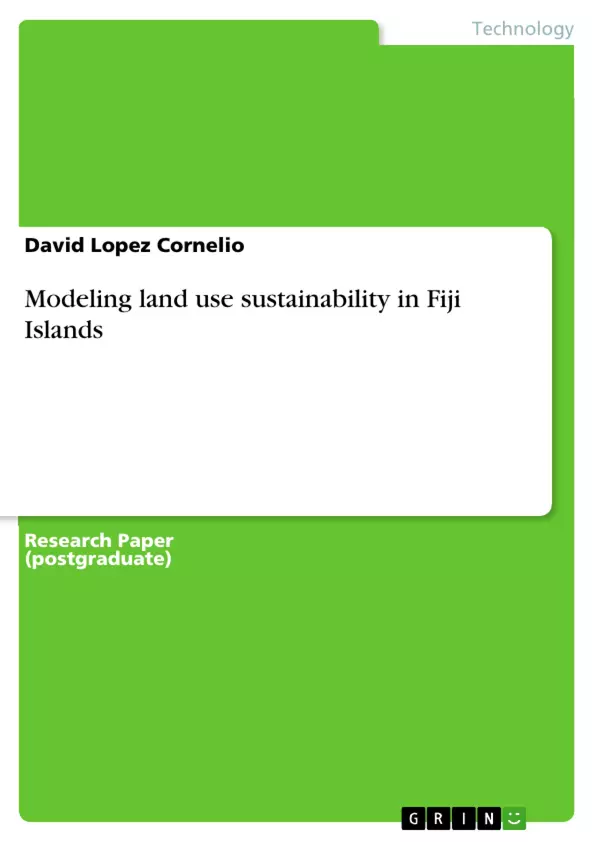Fiji Islands are among the most dynamic economies in the South Pacific, with rapid changes on infrastructure and industrial developments, tourism and commercial agriculture; even though they often come alongside environmental impacts on endemic biota and ecosystems that are not well understood, not much is invested on research to plan a sustainable use of land. Parallel unsolved concerns are land tenure issues in which ancestral community ownership coexists with modern markets; tensions over land leases between ethnical groups and high population growth trigger land use intensification, and rise of emigrations, of landlessness, of unemployment and finally of poverty. Therefore, it is of a national interest to asses these trends for long term sustainable land use planning; even nearly 3500 years ago a record of regulations aimed to achieve sustainability and equality: “3 …for six years you may plant crops inyour fields, prune your vineyards, and gather what they produce. 4 But during the seventh year, you must let the land rest. 8 Count seven of these years seven times for a total of 49 years... during that time there will be seven ·years of rest 9 and proclaim liberty to everyone living in the land... everyone is to return to their own property” (Leviticus 25).
In this document, the first chapter is a synopsis of land use in the rural areas of Fiji islands, its evolution, types, problems and alternatives, the second chapter is a review of some common free gis packages available in the internet useful for forestry and land use evaluations, their number and degrees of sophistication are ever growing; the last two chapters are applications, first on detecting the severity of land use intensity in relation to other socioeconomic parameters, and second on the planning of the best places for planting trees of economic or ecological importance. The articles were presented at international conferences, they are in no way a comprehensive treatise on the subject; my main purpose is to ignite the interest of students and staff working in the forestry field to try on and propose projects of various types, scales and complexity, with just a standard PC and access to internet and library resources.
Inhaltsverzeichnis (Table of Contents)
- A synthesis on land use changes and agroforestry in Fiji Islands
- Abstract
- 1.0 Introduction
- 2.0 Geography and land use evolution
- Alternatives on GIS&RS for forestry applications in the Pacific Islands
- Socioeconomic drivers of shifting cultivation in Fiji Islands: a geographical
- Land suitability for the plantation of important tree species in Vitilevu Island, Fiji
Zielsetzung und Themenschwerpunkte (Objectives and Key Themes)
This document aims to provide an overview of land use issues in Fiji Islands, including their historical development, current challenges, and potential solutions through agroforestry practices. The document also explores the use of GIS and RS technologies for forestry applications in the Pacific Islands.
- Land use changes and agroforestry in Fiji Islands
- GIS and remote sensing (RS) for forestry applications in the Pacific Islands
- Socioeconomic drivers of shifting cultivation in Fiji Islands
- Land suitability for tree plantation in Vitilevu Island
- Sustainable land use planning in Fiji Islands
Zusammenfassung der Kapitel (Chapter Summaries)
The first chapter provides a comprehensive overview of land use changes and agroforestry in Fiji Islands. It examines the historical evolution of land use, the current state of agricultural practices, and the environmental impacts associated with them. The chapter then delves into the potential of agroforestry as a sustainable alternative for land management in the islands.
The second chapter focuses on GIS and RS technologies, exploring their applications in forestry management in the Pacific Islands. It discusses the availability and usefulness of various free GIS packages for forestry and land use evaluations.
The third chapter examines the socioeconomic drivers of shifting cultivation in Fiji Islands, analyzing the geographical factors that influence this practice and its impact on the environment and local communities.
The fourth chapter focuses on land suitability for the plantation of important tree species in Vitilevu Island. It explores the factors that determine the suitability of different areas for specific tree species and provides insights into the planning of optimal locations for tree planting.
Schlüsselwörter (Keywords)
The key topics explored in this document include land use, agroforestry, GIS, RS, shifting cultivation, land suitability, tree plantation, sustainability, and Fiji Islands.
- Citation du texte
- David Lopez Cornelio (Auteur), 2017, Modeling land use sustainability in Fiji Islands, Munich, GRIN Verlag, https://www.grin.com/document/351842



